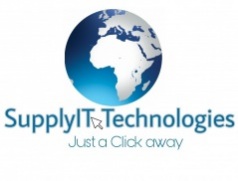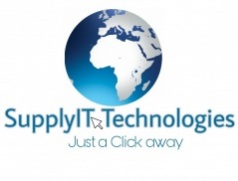Network Support
Network install and maintenance, Network Managed Services, Network Design Services and IT Infrastructure Services

IT Support
Professional IT services support and solutions. Dedicated support team with different expertise that proactively works on your systems.

Hardware & Software Sales
We source all major hardware and software brands. PC hardware & laptops sales. Laptop and computer repairs...

We are Just a Click away.
Get realtime response from Supply IT Technologies support Team, Increase Performance and Productivity in your Company or Organization. We aim to solve IT related problems in a way that is affordable and exceeds the expectations of our clients.
Happy Clients
Projects Completed
Positive Feedback
About Us
Our Core Business
Supply IT Technologies provides IT Solutions that are affordable, secure and robust. We service National and surrounding areas. Supply IT Technologies has a dedicated support team that provides remote and onsite support to our clients.
OUR PHILOSOPHY - is to Provide cost effective IT solutions to businesses by implementing open source technologies wherever possible without bias towards a particular technology.



58
127
96%

Our Values
- Sustainability
- Customer oriented
- Teamwork
- Respect
- Integrity
- Professional Service
- Accountability
- Innovation
For the Past 4 years Supply IT Technologies has been providing quality and reliable services to our clients and they rely on us simply because we have proven to be what we value:
Backup Services
Your business is completely reliant on technology and data for day-to-day operations. Let our support company help back it up.

IT Relocation
When moving offices, you need your IT systems to be up-and-running as quickly as possible. Our relocation service will help you get there.

VOIP
VOIP telephony saves money for your organisation and improves both portability and flexibility for your workforce.

Our Project References
Sectors We Support
Financial Services Sector
Legal Services Sector
Architect Practices Sector
Professional Services Sector
Charity or Non-Profit Organisations
Retail Sector






Latest IT News
Is Africa Ready for Digital Enablement?
The World Economic Forum (WEF) believes that there are five hotspots that need to be targeted by the public sector in Africa and the theme that underpins them all is… digital. Digital is the infrastructure that the public sector needs to enable skills development, innovation, connectivity, economy and data-driven insights.
Digital enablement is the firelighter that can potentially ignite the public sector’s ability to engage with citizens and reshape economic growth. But, according to Sina Mvoko, Managing Executive Public Sector at BCX, it has to be implemented and approached with strategic grace rather than the blunt hammer of square solutions shoved into round holes.
“Digital enablement is about just that, enabling – empowering the public sector in achieving its goals as a vehicle for the country and its people,” she adds.
“It is not a quick win or an easy fix, it’s a steady and methodical approach to implementing digital solutions and capabilities throughout the sector in ways that are sustainable and strategic. The value of digital lies in its ability to redefine legacy systems, improve processes, reduce costs, and ignite economies and this value must be embedded throughout any public sector investment.”
The question is; in light of the existing system and infrastructure complexities, can the public sector see this value? It’s hard to believe in the hype when technology has, in the past, been a slow and lumbering beast more inclined to error than efficiency. This understandable hesitation is causing many governments to fall behind the private sector when it comes to catching hold of digital and its potential.
There is deeper accountability and far more complex legacy infrastructure. But, the time to change is now. In a recent whitepaper entitled ‘Global Agenda Council on the Future of Government’, the WEF called governments the ‘dinosaurs of the digital age: slow, lumbering and outdated’.
“The rapid and ongoing evolution of digital solutions and capabilities has meant that the world is spinning into digital transformation and the much-talked-about Fourth Industrial Revolution (4IR) at a pace that few governments can manage,” says Mvoko.
“This is what makes digital enablement for this sector so critical. Governments have to be ready; they have to be capable of offering citizenry and enterprise the toolkits and capabilities they need to drive the economy forward.”
The next question is, of course, how? How does the public sector move into digital transformation? According to research undertaken by Deloitte, around 89% of leaders aren’t sure how to build the organisation of the future and they’re hardly encumbered by the same limitations and restrictions as the public sector. This is not an easy journey, but it is one that can be undertaken with the right tools, approaches and partners.
“Digital enablement is about creating strategies through design thinking and innovation-based decision making to find the best possible digital roadmap for the public sector,” says Mvoko.
“The strategy is essential as this is the bridge between what the sector is today, and what it needs to be tomorrow. Design thinking and innovation-driven decision making are what pull the threads of strategy into a holistic ecosystem that gets relevant results.”
Partnerships are key. Digital transformation needs trusted and transparent partnerships because the public sector doesn’t have the bandwidth to unwrap the nuances of digital to ensure it gets the best results. Partners have the expertise and the foundations within digital to provide the right roadmaps and guidance for a sector that’s urgently in need of stability and growth.
“Digital enablement has the potential to bring immense value to the public sector,” concludes Mvoko. “It may not be clear where it has to start or what digital solutions are the most important, not at first. This will be unlocked through engagement with partners that can help the sector manage multiple objectives, limited budgets and vast scope. Through this careful analysis and insight, the sector will discover the value of digital and build a solid foundation for the future.”





